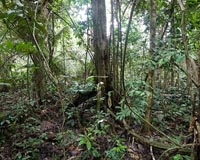| . |  |
. |
Mainz, Germany (SPX) Sep 23, 2010 The air above the Amazon rainforest is cleaner than almost anywhere else on earth. This allows climate scientists to investigate cloud condensation under natural conditions. The results of this study may serve as a point of reference for future analyses of anthropogenic influence on cloud evolution and precipitation. Scientists from the Max Planck Institute for Chemistry have now made a valuable contribution to this. Together with international partners, they have, for the first time, used scanning electron microscopy and mass spectrometry during the rainy season to characterise the chemical composition of aerosols, tiny suspended particles in the air above the Amazon rainforest. Submicron particles have a diameter that is smaller than a thousandth of a millimetre and serve as cloud condensation nuclei. They consist of 85 % secondary organic aerosol components. These are formed from volatile organic compounds which are released by the forest ecosystem and which can be converted to low-volatile particles through photochemical reactions and condensate. The remaining tenth of the submicron particle primarily consists of salts, minerals and soot, transported from the Atlantic and Africa by the winds.
A self-contained hydrological cycle above the Amazon rainforest The fact that aerosols above the Amazon rainforest are nearly completely of biogenic origin tells the scientists a lot about the ecosystem. "The Brazilian rainforest during the rainy season can be described as a bioreactor", says Ulrich Poschl, who played a leading part in the study. Water vapour rises from the forest, compensating on aerosols. These are then transported up to a height of 18 kilometres. Water droplets and ice crystals grow in the clouds thus formed until they fall to the ground again as precipitation. Part of the precipitation evaporates and the rest irrigates the Amazon flora. The plants, while growing, continue to release organic material into the atmosphere, on which new clouds grow.
The cloud evolution above the Amazon is limited by the abundance of aerosols "We are already able to say that the number of cloud droplets over the Amazon rainforest is aerosol-limited, which means that it depends on the number of aerosol particles which is released by the ecosystem", explains Ulrich Poschl. In densely populated areas and in the Amazon during the dry season, where exhaust fumes from traffic, industry and slash-and-burn agriculture saturate the air with aerosols, it instead depends on the velocity of the updraft which transports the particles upwards. The scientists want to continue to investigate the atmosphere above the Amazon rainforest in the next years. For this purpose, they are now erecting a 300 metre high observational tower near Manaus, Brazil, where the current studies were carried out. "There, we want to conduct further long-term and comprehensive observations", says Ulrich Poschl. Besides the aerosols, the scientists also want to look closer at the carbon and nitrogen cycles. "If we can better understand the natural ecosystem of the rainforest, we will be able to describe the influence that we humans exert on the climate more reliably."
Share This Article With Planet Earth
Related Links Max Planck Institute for Chemistry Forestry News - Global and Local News, Science and Application
 Pristine Rainforests Are Biogeochemical Reactors
Pristine Rainforests Are Biogeochemical ReactorsRaleigh NC (SPX) Sep 17, 2010 A multinational team that includes a North Carolina State University researcher has found another piece of the atmospheric puzzle surrounding the effects of aerosol particles on climate change. Their findings will contribute to our ability to more accurately measure human impact on climate, and to determine how much pollution may "mask" the actual rate of climate change. Dr. Markus Petters ... read more |
|
| The content herein, unless otherwise known to be public domain, are Copyright 1995-2010 - SpaceDaily. AFP and UPI Wire Stories are copyright Agence France-Presse and United Press International. ESA Portal Reports are copyright European Space Agency. All NASA sourced material is public domain. Additional copyrights may apply in whole or part to other bona fide parties. Advertising does not imply endorsement,agreement or approval of any opinions, statements or information provided by SpaceDaily on any Web page published or hosted by SpaceDaily. Privacy Statement |